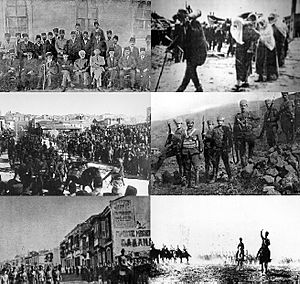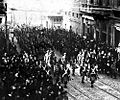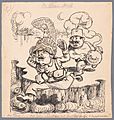Turkish War of Independence facts for kids
Quick facts for kids Turkish War of Independence |
|||||||||
|---|---|---|---|---|---|---|---|---|---|
| Part of the Revolutions of 1917–1923 in the aftermath of World War I |
|||||||||
 Clockwise from top left: Leaders meeting at the Sivas Congress; Turkish people carrying supplies to the front; Kuva-yi Milliye soldiers; Turkish horse cavalry; Turkish Army's capture of Smyrna; troops in Ankara's Ulus Square preparing for battle. |
|||||||||
|
|||||||||
| Belligerents | |||||||||
|
Turkish Nationalists: Supported by:
(1919–1920) (from 1921) |
Entente: (in 1920) (in 1921) Seperatists:
|
||||||||
| Commanders and leaders | |||||||||
| Strength | |||||||||
November 1920: 86,000 (creation of regular army) August 1922: 271,000 |
1922: 200,000–250,000 |
||||||||
| Casualties and losses | |||||||||
22,690 died of disease 5,362 died of wounds or other non-combat causes 35,000 wounded 7,000 prisoners |
18,095 missing 48,880 wounded 4,878 died outside of combat 13,740 prisoners 3,000+ prisoners |
||||||||
| 264,000 Greek civilians killed 60,000–250,000 Armenian civilians killed 15,000+ Turkish civilians killed in the Western Front 30,000+ buildings and 250+ villages burnt to the ground by the Hellenic Army and Greek/Armenian rebels. |
|||||||||
|
Notes
|
|||||||||
The Turkish War of Independence (May 19, 1919 – July 24, 1923) was a major conflict. It happened after the Ottoman Empire lost World War I. Parts of the empire were taken over by other countries. This war was fought by the Turkish National Movement. They fought against Greece in the west, Armenia in the east, and France in the south. They also fought against some local groups and British and Ottoman troops around Istanbul. This war was part of a bigger effort to resist the breakup of the Ottoman Empire.
Contents
Why the War Started
After World War I ended, the Ottoman Empire signed an agreement called the Armistice of Mudros. But the winning countries, known as the Allied Powers, kept occupying and taking land. They were following secret agreements like the Sykes–Picot Agreement. Ottoman military leaders did not want to give up their forces. This led to a big problem. The leader of the Ottoman Empire, Mehmed VI, sent a respected general named Mustafa Kemal Pasha. He was sent to Anatolia to bring back order. But Mustafa Kemal became a leader of the Turkish nationalists. They resisted the Ottoman government and the Allied powers.
To gain control in Anatolia, the Allies asked the Greek Prime Minister, Eleftherios Venizelos, to send troops. These troops occupied Smyrna (now İzmir). This made tensions worse and started the Turkish War of Independence.
The Rise of the Turkish National Movement
Mustafa Kemal and his supporters formed a new government in Ankara. This was called the Government of the Grand National Assembly. They did this because the Ottoman government in Istanbul seemed to be giving in to the Allied powers. The Allies then forced the Ottoman government to stop its own laws and close its parliament. They also made them sign the Treaty of Sèvres. This treaty was very unfair to Turkish interests. The new "Ankara government" said this treaty was illegal.
Key Battles and Victories
During the war, local fighters worked with Syrian rebels. They defeated the French forces in the south. Turkish units also worked with Bolshevik forces to divide Armenia. This led to the Treaty of Kars in October 1921.
The fighting in the west was called the Greco-Turkish War. At first, Greek forces faced unorganized resistance. But İsmet Pasha organized the local fighters into a regular army. This new army fought the Greeks in the First and Second Battle of İnönü.
The Greek army won the Battle of Kütahya-Eskişehir. They decided to march towards Ankara, the nationalist capital. This stretched their supply lines very thin. The Turks stopped their advance in the Battle of Sakarya. Later, they launched a big attack called the Great Offensive. This attack pushed Greek forces out of Anatolia in just three weeks. The war ended when İzmir was taken back by the Turks. This led to a new agreement called the Armistice of Mudanya.
The Birth of Modern Turkey
The Grand National Assembly in Ankara was recognized as the true Turkish government. They signed the Treaty of Lausanne in July 1923. This treaty was much better for Turkey than the earlier Sèvres Treaty. The Allied forces left Anatolia and Eastern Thrace. The Ottoman government was removed, and the rule by a sultan was ended.
On October 29, 1923, the Grand National Assembly of Turkey declared the Republic of Turkey. This assembly is still Turkey's main law-making body today. The war brought an end to the Ottoman era. There was also a population exchange between Greece and Turkey, where many people moved between the two countries. With Atatürk's reforms, Turkey became a modern, secular nation. In March 1924, the Ottoman caliphate, a religious leadership role, was also ended.
The war and events before it greatly changed who lived in Turkey. Many Christian people, including those who spoke Greek and Armenian, left or were forced to move from Anatolia. This led to a big increase in the Muslim population, from about 80% to 98%.
Images for kids
-
Grand Vizier Ferid Pasha, a leader of the Freedom and Accord Party
-
People who moved from the Balkan Wars waiting to cross the Bosphorus to Anatolia, Sirkeci, Istanbul, 1912
-
Ahmed Tevfik Pasha and Rıza Tevfik at the Paris Peace Conference
-
Greek troops marching in İzmir in May 1919.
-
The opening of the Grand National Assembly of Turkey
-
Borders and areas of influence of the Ottoman Empire based on the Treaty of Sèvres (1920). This treaty was later replaced by the Treaty of Lausanne in 1923.
-
A 1922 painting showing the Turkish recapture of İzmir on September 9, 1922
See also
 In Spanish: Guerra de Independencia turca para niños
In Spanish: Guerra de Independencia turca para niños
- Timeline of the Turkish War of Independence
- Medal of Independence
- Young Turk Revolution
- 31 March Incident
- Celali rebellions
- List of modern conflicts in the Middle East


















